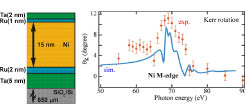Discovery of a Giant Kerr Rotation in a Ferromagnetic Transition Metal by M-edge Resonant Magneto-Optic Kerr Effect
I. Matsuda and Shin Groups
Magneto-optical effects are one of the central topics in condensed matter physics. The effects have been used to study magnetism and spin transport in materials. Many experiments with the magneto-optical Kerr effect (MOKE) have been performed using linearly polarized laser light of a single wavelength typically in the visible region. Recently, there has been remarkable progress in new-generation light sources, such as the X-ray free-electron laser (FEL) and the high-harmonic generation (HHG) laser. These new monochromatic lasers have ultra-short pulse widths and tunable photon energies ranging from the extended violet to the X-ray region. Thus, MOKE measurements with photon energy tuned at the absorption edge (so-called resonant MOKE or RMOKE) are of considerable interest. Measurements with the new-generation light sources are expected to be element-specific and to trace spin dynamics in real time via time-resolved measurements.

Fig. 1. Photon energy dependence of the Kerr rotation angle, θk, of the Ni film calculated with the resonant scattering theory (sim.) and measured experimentally with VUV synchrotron radiation (exp.). Measurement was performed at room temperature under a magnetic field of B = ± 0.47 T.
In the present research, we have studied the Kerr rotation angle and ellipticity in the RMOKE at photon energies corresponding to the M-shell absorption edge of transition metal. We investigated the RMOKE in the well-known nickel film both theoretically and experimentally. The simulation was carried out with resonant scattering theory based on the Kramers-Heisenberg formula. The predicted Kerr rotation angle indicated a large MOKE (> 10˚). Then, the large Kerr rotation angle was confirmed by rotating analyzer ellipsometry using vacuum ultraviolet (VUV) synchrotron radiation at KEK PF BL-18A. Figure 1 compares experimentally measured and calculated variations of θk with photon energy. The experiment reproduced large θk values (~10 degree) at the absorption edge: the overall features are in good agreement with the calculations, where the model parameter set has been independently determined with other core-level spectroscopies.
Since the RMOKE measurement is inherently element specific and is a photon-in and photon-out experiment, it is able to probe spin states of selected elements in complicated magnetic materials under external electromagnetic fields. Moreover, we observed a large Kerr rotation angle (> 10˚) in the RMOKE, which is much larger than angles (<1˚) typically found for the MOKE with visible light. Conventional MOKE measurement has always required lock-in amplifier techniques to obtain a high enough signal-to-noise ratio. However, the large Kerr rotation angle in the RMOKE we observed does not require such techniques. This advantage allows us to detect the magnetism or spin dynamics of a very small amount of the magnetic element in a material, such as a dilute magnetic semiconductor, or to measure very small structure, such as the magnetic nanostructure on a surface. This feature makes it possible to trace these ultrafast spin dynamics in terms of individual chemical species in real time when combined with FEL or HHG lasers.
References
- [1] Sh. Yamamoto, M. Taguchi, M. Fujisawa, R. Hobara, S. Yamamoto, K. Yaji, T. Nakamura, K. Fujikawa, R. Yukawa, T. Togashi, M. Yabashi, M. Tsunoda, S. Shin, and I. Matsuda, Phys. Rev. B 89, 064423 (2014).
